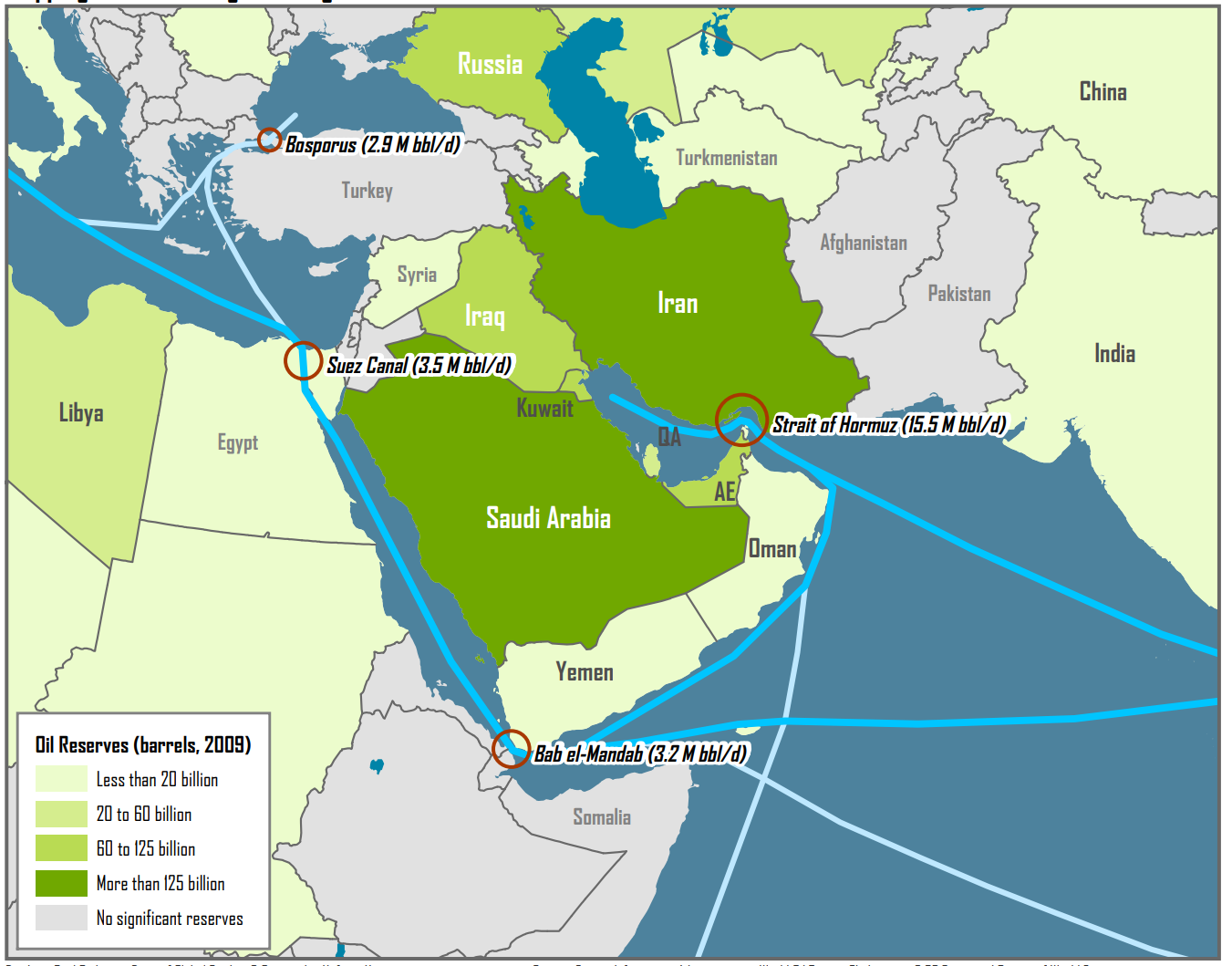
The U.S. Energy Information Administration (EIA) identifies six straits and canals as world oil transit chokepoints: the Strait of Hormuz, the Strait of Malacca, Suez Canal, the Bosporus, the Bab el-Mandab, and the Panama Canal. Since tanker traffic accounts for nearly two-thirds of the world’s trade in oil, the security of shipping is of paramount importance. These six chokepoints are defined by their geographically constrained waterways and the high volume of oil tanker traffic. These bottlenecks are critical to shipping oil and are, at least theoretically, highly susceptible to piracy and shipping accidents.
The Strait of Malacca is widely considered the most vulnerable chokepoint, although it is perhaps the easiest to circumvent during a disruption. The Strait is a narrow stretch of water nearly 500 miles long separating the Malaysian Peninsula and the Indonesian island of Sumatra. Approximately 12 million barrels of oil are shipped through this narrow thoroughfare each day. At its narrowest point, in Phillips Channel in the Singapore Strait, the channel is roughly 1.5 miles wide. Malacca is narrow and quite shallow – less than 22 meters in some spots. Dangers include collision, accidents, grounding (due to the shallow sea floor) and piracy. Over 50,000 vessels transit Malacca each year, probably because it is the shortest (and therefore cheapest) shipping route between Japan, South Korea, China and the Middle East oil fields. The nearby Straits of Makassar and Lombok provide alternate routes at a marginal cost increase, ” not the preferred ways during peacetime, but possible routes that would require little increase in cost during a disruption. In severe disorder, ships could transit to East Asia by travelling around Australia, remaining in the open ocean and adding only a few days of transit time.
The Strait of Hormuz is a narrow waterway that connects the Persian Gulf and the Gulf of Oman – the only passage from the oil-rich gulf to the Indian Ocean for maritime traffic. The Strait is among the world’s most important oil chokepoints. Oil tankers carry approximately 17 million barrels of oil each day through the Strait, or 20 to 30 percent of the world’s total consumption. Other outlets for oil exports from the region, such as pipelines, are limited. As such, approximately 88 percent of all oil leaving the Persian Gulf goes via the Strait of Hormuz.
The Strait itself is about 30 miles wide at the narrowest point. In order to regulate the movement of large ships in these constrained waters, the UN’s International Maritime Organization has recognized a Traffic Separation Scheme (TSS). The TSS consists of two, two-mile-wide shipping lanes: one for incoming and outgoing traffic. These two shipping lanes are separated by a two-mile buffer zone. Overall, the narrow confines of the TSS offer oil tankers and other large commercial (and military) ships very little room for maneuver and little capability to avoid obstructions within the TSS. However, much more of the Strait than the TSS is deep enough for even the largest oil tankers. As a result, for a barrier to ship traffic to disrupt the flow of oil, it would have to cross the width of the Strait not just the narrow band of the TSS.
The Strait of Hormuz is geo-strategically important to the United States, as the health of the world economy depends on the flow of oil. Many pundits and analysts, often cited by politicians and the media, fear that an Iranian attempt to close the Strait would threaten the global economy. Their implicit assumption is that Iran could stop the transit of a substantial amount of oil through the Strait for a prolonged period of time. However, as the information on this website illustrates, creating a major disruption in the Strait would be extremely difficult due to the region’s various economic, political and military forces today.
What incidents have happened recently in the Strait of Hormuz?
Iran’s Revolutionary Guards seized two British oil tankers in retaliation to Britain’s act of “piracy” in detaining and seizing the Iranian oil tanker Grace 1 off Gibraltar.
June 2019: Marshall Islands-flagged Front Altair and Panama-flagged Kokuka Courageous rocked by explosions after sailing through the Strait of Hormuz.
June 2019: Iran shoots down a US drone flying near the strait.
July 2019: Iran seizes UK-flagged vessel Stena Impero
July 2019: U.S. shoots down Iranian drone near the American warship USS Boxer.
April 2020: Hong Kong-flagged, SC TAIPEI boarded by IRGC.
July 2020: Iran launches missiles at a mock-up of a US aircraft carrier in the Strait of Hormuz.
Feb 2021: Explosion – Gulf Of Oman Vehicle Carrier MV HELIOS RAY (IMO9690547) has suffered an explosion within the Gulf of Oman.
Source: strausscenter.org & transportgeography.org

